In a time before Down-Country there was an other MTB niche with not-much-travel but built for fun.
From Singletrack Magazine Issue 52:
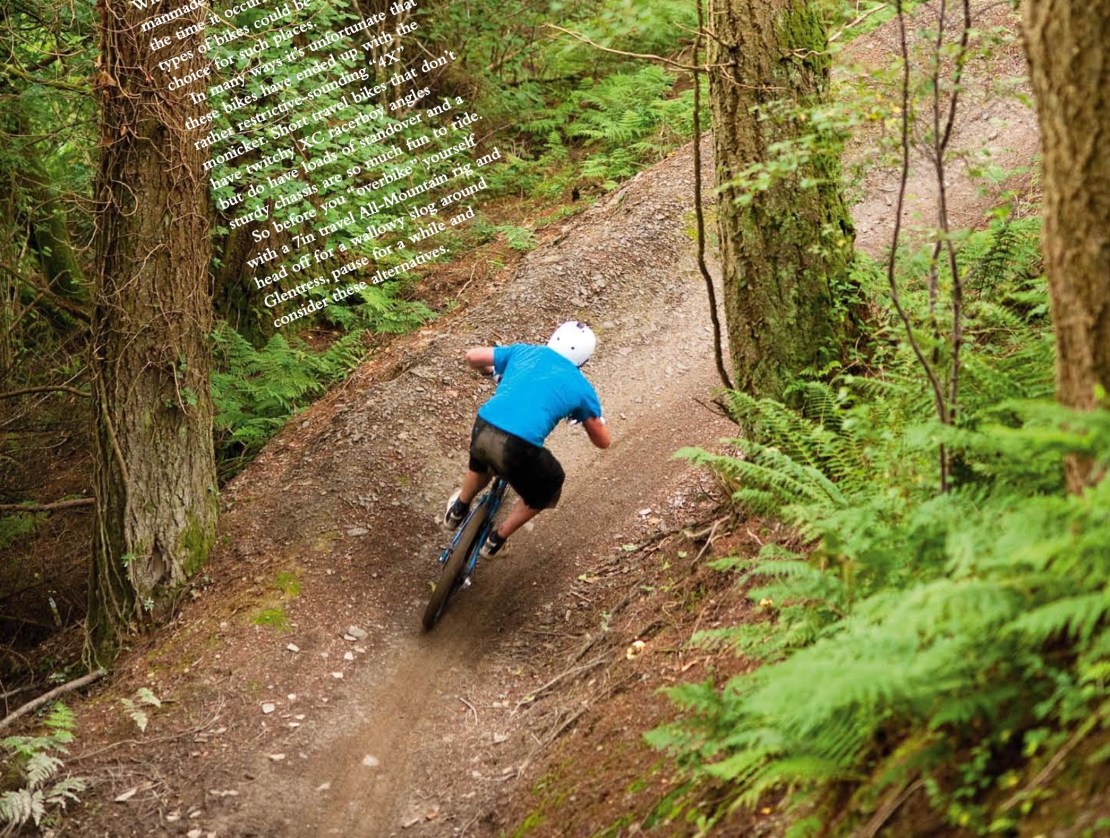
Benji and the Singletrack Test Squadron try out a breed of bikes that might not have much in the way of suspension travel but ar potentially some of the funnest mountain bikes you can find.
With the modern phenomenon of manmade trail centres expanding all the time it occurred to us that the types of bikes could be the perfect choice for such places.
Latest Singletrack Merch
Buying and wearing our sustainable merch is another great way to support Singletrack
In may ways it’s unfortunate that these bikes have ended up with the rather restrictive-sounding “4X” monicker. Short travel bikes that don’t have twitch XC racer boy angles but do have loads of standover and a sturdy chassis are so much fun to ride.
Commencal VIP Meta 4X
- PRICE: £1175 frame only
- FROM: Madison www.madison.co.uk
- WEIGHT: 30.5lbs
- PERSONA: Billy’s Boots
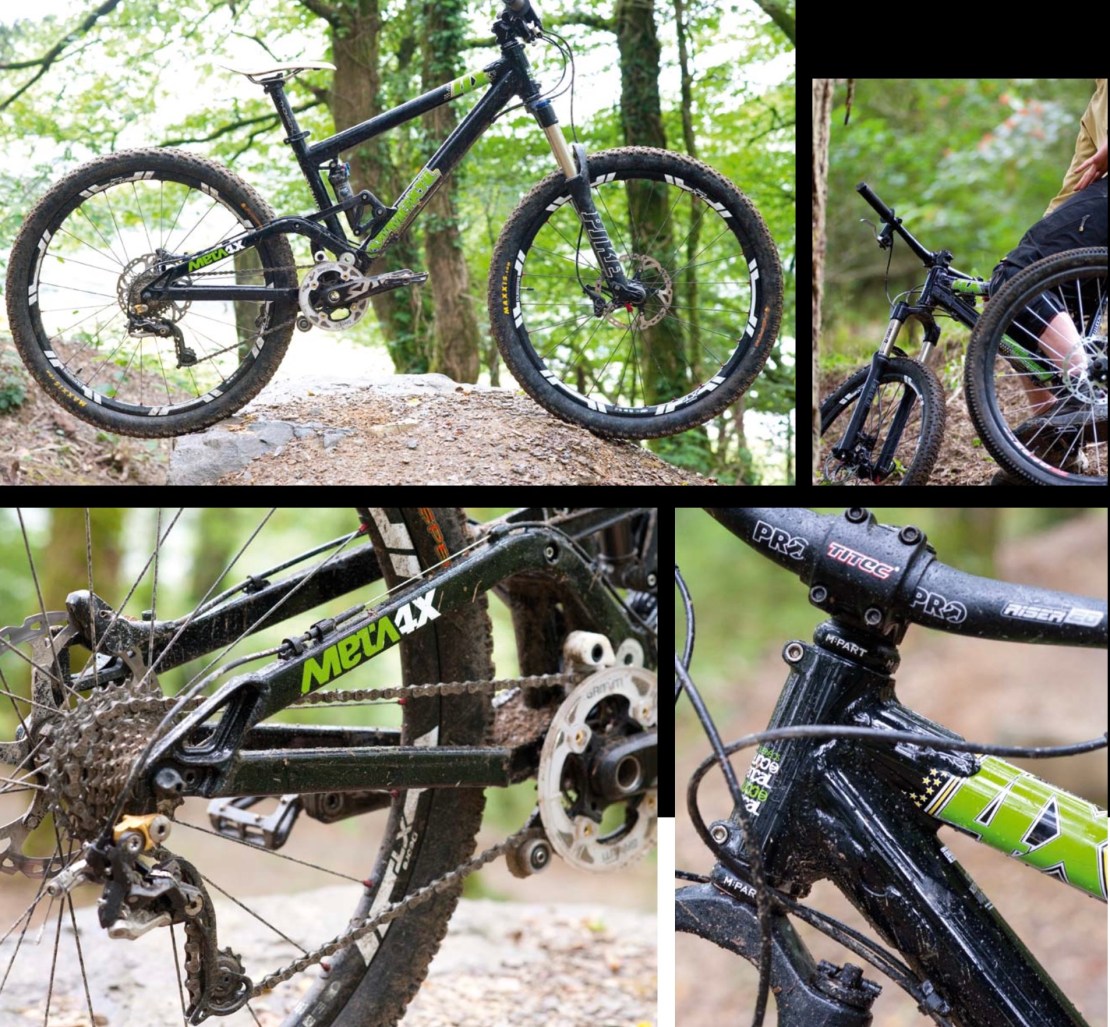
Commençal’s Meta range is one of the biggest success stories of recent years in the UK. Us Brits appear to have really taken a shine to these quintessentially Gallic bikes. The Meta 4X shares the same amount of travel as the overtly XC-orientated Meta 4 (100mm) but how the tubes have been put together is significantly different. The Detail The Meta 4X is only available as a frame (as part of Commencal’s VIP series). As it happens the Meta 4X that we tested was the personal bike of Olympic BMXer Shanaze Reade. And looking at the build kit it’s clear that no expense was spared in putting it together. But let’s just concentrate on the frame. It uses the same tried-and-tested suspension system – a linkage driven single pivot that Commencal have dubbed the “Contact System”. Being single pivot means there’s no fancy axle path or “independent braking” stuff going on. And when you’re dealing with a relatively short amount of travel we think there’s very few problems with the single pivot design. The triangular linkage that sits between the rear swing arm and the rear shock is there to do two things: it removes the shock from being a structural member of the frame and it can also alter the spring rate of the suspension. Not having the shock as a structural part of the frame makes for a stiffer chassis and reduces wear on the shock (bushings and seals etc). The 4X shares the same nominal head angle as the Meta 4 (69.5 degrees) but pretty much everything else is different. The seat angle is 73 degrees (not 70). Comparing this “Long” sized 4X to a “Large” Meta 4, the head tube is 9mm shorter (at 111mm) even with the internal adjustable head tube sleeve that can tweak the head angle one degree slacker or steeper. The seat tube is 14.75in (not 19.6in) – and as such offers masses more standover albeit at the expense of a pedal-able saddle height for taller riders. The effective top tube length
is 22.8in (not 23.7in). And the BB is a whopping 2mm lower. So the most significant results are a lower front end, a shorter top tube and increased standover. The tubing has a bit more wall-thickness to it and the gussetry is meatier. So it weighs a bit more but should be significantly stiffer (especially factoring in the smaller front triangle). The Ride Do you remember a cartoon in The Eagle called “Billy’s Boots”? The basic premise was that a kid got hold of the football boots of an old soccer ace and when he wore them he found he had the same supreme skills as said old soccer ace. Well, when we were riding this Meta 4X (Shanaze Reade’s Meta 4X) it felt like a similar thing was happening. There was something about it that made us think we could rip around trails like an Olympic BMXer rips around a track. Leaning it over at outrageous angles through berms and pumping it through all and every dip in the trail for more ‘free’ speed. Like most of the bikes in this test it initially felt a bit on the short side reach-wise. This felt a bit cramped when climbing and a bit endo-inducing on steep descents. But this shortness came into its own on the contouring “rollercoaster” type trails – which there’s no shortage of in your average trail centre. On this sort of terrain the bike was an absolute blast. On less-groomed trails the Meta 4X belied its modest 4in of travel – its low slung centre-of-gravity and general stout feel kept it online and under control through sections that 4in travel XC bikes would have come unstuck on. The Meta didn’t have the same instant “snap” as the Foes. This wasn’t entirely due to the Foes’ Curnutt Wunder-shock; the Meta’s heavier overall weight was a contributory factor. All that burly Shimano Saint stuff piles on the pounds.
Foes 4X 2:1
- PRICE: £1779 frame only (+£520 for Curnutt shock)
- FROM: Balfa www.balfa.co.uk
- WEIGHT: 28lbs
- PERSONA: Star Rider
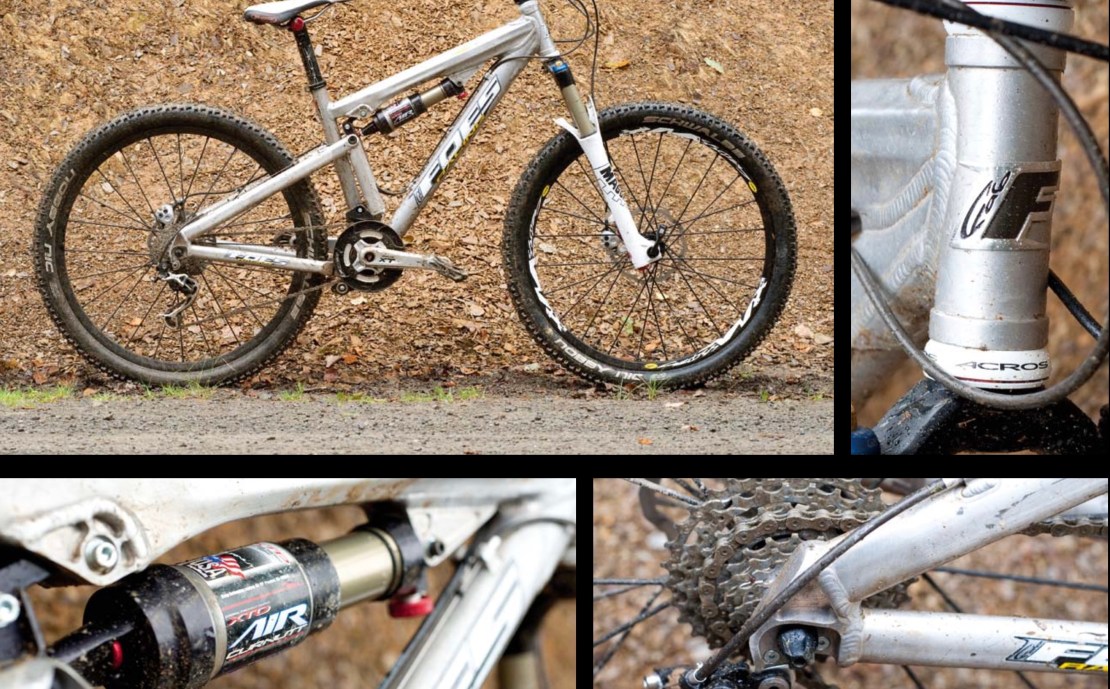
Foes are very much a cult brand. They’re kind of like Intense, only more so (if you know what we mean). Made in the USA, muscley looking bikes, made in small production numbers, under the supervision of one man (Brent Foes). Like Intense they have a large array of different models in their range from XC race rigs through to full-on DH monsters. The Detail The 4X is intended for racing 4X (duh) or hitting dirt jumps. However, as with the rest of the bikes on test, we took it around a selection of UK trail centres to see how it fared on them. The bike has 4in of travel at the back handled by the chunkily oversized Curnutt air shock.You can get the frame with a Fox RP23 shock but doing that would be like getting a Lamborghini in a subdued colour – sacrilege. The “2:1” name refers to the fact that the frame works on low leverage ratio; 2 inches of shock compression gives 4 inches of rear wheel travel. The idea behind this (and the general oversizing of the shock) is to reduce how hard the shock has to work. This aspect is arguably more relevant on long travel bikes but on the 4X it does make for a shock that is easy to setup as it isn’t so reliant on having the precise amount of pressure in it. The shock has an adjustable “rod end” that can lengthen the shock to steepen the geometry and raise the BB height slightly. We left it in the slack and low position. The Easton EA6X aluminium frame looks muscley and taut. There’s big gussets at the head tube and the flared out monocoque top tube (which is something of an aesthetic signature on most Foes bikes) gives out an air of confidence, nay aggression. The suspension design is a linkage driven single pivot. The swing
link is short but very substantial in its construction. One of Foes’ “things” is chassis stiffness – everywhere you look on the 4X frame you can see this. Here’s some geometry for you: 69 degree head angle, 74 degree seat angle, 12.9in BB height, 21.1in effective top tube (on our 16in model). The Ride Basically it is impossible to “just ride along” when you’re on board the Foes 4X. It seems to take any input and multiply it. It shoots forward like a road bike when you press on the pedals. It seems to begin turning before you’ve even thought of it. It will get airborne as frequently as possible whether you like it or not. In many ways it’s actually a bit of a handful to ride. If you’re up for it (or indeed up to it) you’ll end up in the undergrowth before too long. But if you want a “Porsche 911 on a track day” experience this is the bike for you. It’s resolutely not an XC bike. Although it feels jet propelled under pedalling, the short top tube makes for an inefficient climbing position (both sat down and out of the saddle). The ride was the closest to a BMX of all the bikes here – which is both a great thing and a limiting factor. It struggles on steep downhills where its balletic nature can only get you out of so much trouble – and its short reach and high-ish BB is a recipe for endos. The suspension action at the back was brilliant. It’s not a cushy ride by any means. The shock does as much as it needs to but no more than that. That’s the whole point of “going Curnutt”. A lot of riders will feel a bit underwhelmed by it because you can’t feel the suspension doing anything. But you’ll find yourself riding faster and more accurately than you have ever done before.
Kona Bass
- PRICE: £1950
- FROM: Paligap www.paligapltd.co.uk
- WEIGHT: 35lbs
- PERSONA: Dan Dare
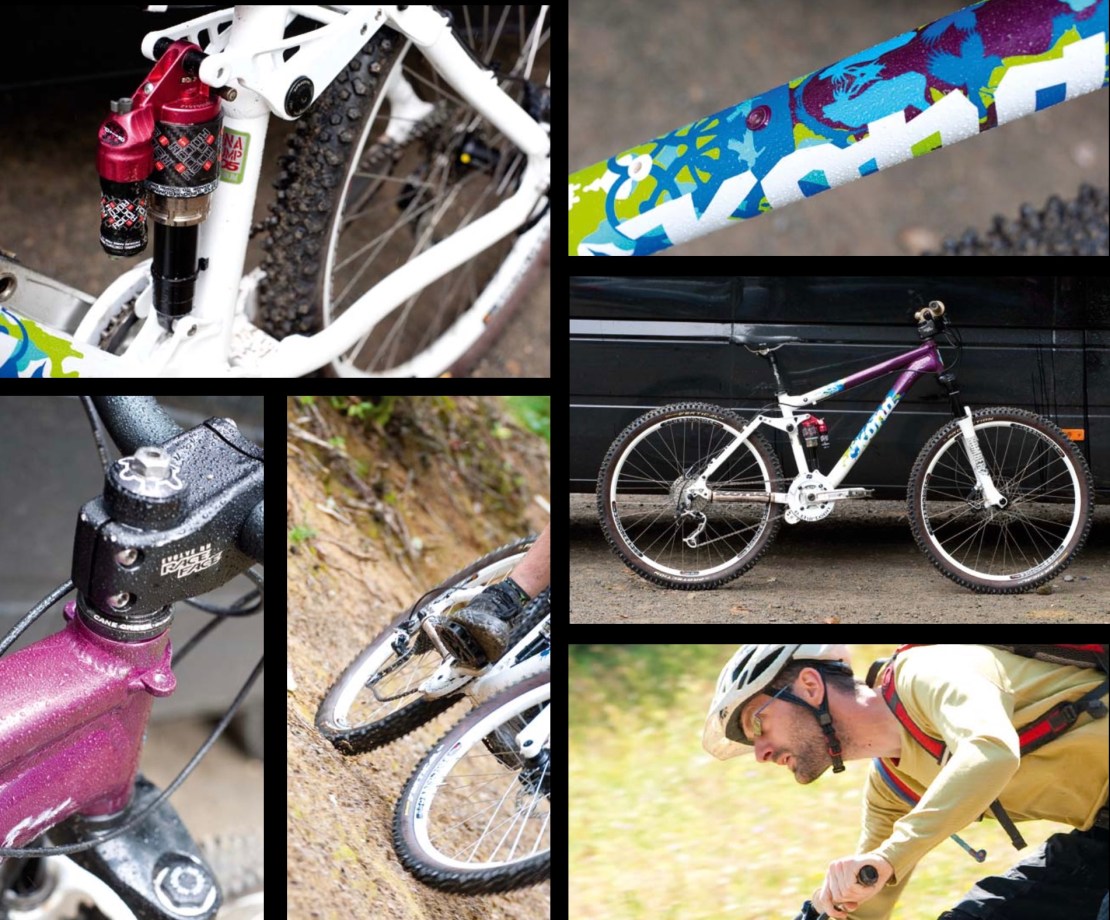
The Bass gets its name from Kona rider Paul Basagotia. Technically it’s not really a 4X bike – it’s part of Kona’s “Out Of Bounds, Slopestyle And Dirt Jump” range. But when we were assembling this test it was one of the first bikes we thought of that fitted our original “shorttravel-but-aggro” remit (that for reasons of practicality we’ve ended up calling “4X Bikes”). The Detail Like a lot of Kona bikes designed for heavy duty er… duties, the Bass is very much on the overbuilt side of things. The frame is made from Kona’s proprietary “Clump” 7005 aluminium – and a lot of it. Doing the highly scientific “flicking it with our fingernails” test revealed that the tubing is quite thick walled. That’s not to say there isn’t some thoughtful design gone into the Bass; the down tube is nicely curved for fork crown clearance (what do you mean you can’t do bar spins?) and the pivoting-around-the-BB rear suspension design is not a simple thing to fabricate well. The main (some would say only) reason the Bass uses a pivot around the BB is so you can run the bike as a singlespeed. There also shouldn’t be any pedal feedback (or chain pull) as the rear shock compresses but that’s not really that high up on the list of priorities on a 4in travel bike that’s built for take-offs and landings. Somewhat surprisingly the geometry of the Bass is pretty much XC-trail “normal”. 70 degree head angle, 74 degree seat angle, 13.2in BB height, 23in effective top tube (on our Medium model). The bike is available as a complete bike and the build kit is
definitely relevant to our experience of riding the Bass. Marzocchi Dirt Jumper 1 fork, Marzocchi Roco Air TST rear shock, Shimano M575 disc brakes, E.Thirteen STS chain guide, Race Face Evolve DH bars, stem, seatpost and chainset The Ride The Bass is a great example of how a decent frame can still shine through even when built up with less-than-stellar componentry. The main negatives were the fork and the brakes. And to be fair to Kona, these bits would be perfectly fine for dirt jumping on groomed trails. But even when out on relatively smooth manmade trails the fork was distractingly awful – simultaneously harsh and under-damped – and the brakes were nowhere near powerful enough. But there was something about the Bass that beguiled us. We felt like there was a brilliant bike under all that clunky componentry. So we took the fork and brakes off and stuck a Rock Shox Pike on it and a set of Shimano SLX brakes. Which is a quite a drastic “tweak” admittedly but it was worth it. With a decent fork and non-terrifying brakes the Bass was the very essence of fun to ride. It had none of the finesse of the Foes or the the Commencal. The Bass preferred to be ridden raggedly – clumsily even. Although it didn’t respond with lightning quickness to pedal power or steering input what it did do was give you a bit of leeway when you made an error. When we realised we could “get away with” a bit more on the Bass we noticed we were attempting things we wouldn’t normally attempt.
Pushing our limits. Particularly when it came to jumping – the Bass would be like a little Devil on our shoulder saying “DO IT!”. So we did it. Most of the time we got away with it too. Surprisingly the Bass proved itself to be a very versatile bike. It liked jumps, it liked rollercoaster trials, it liked “natural” rough trails, and despite its steepish head angle and high-ish BB it was pretty darned good at steep sketchy descents too. And yes, we did try the Bass in singlespeed guise. It was pretty fun but the Roco rear shock seemed to bob like crazy under the necessarily choppy pedalling action of singlespeeding. So the 1×9 gearing went back on (the E.Thirteen deserves a special mention for being excellent by the way).
Xprezo Gamjam
- PRICE: £1775 frame only
- FROM: Shore Lines www.shore-lines.co.uk
- WEIGHT: 31lbs
- PERSONA: Doomlord
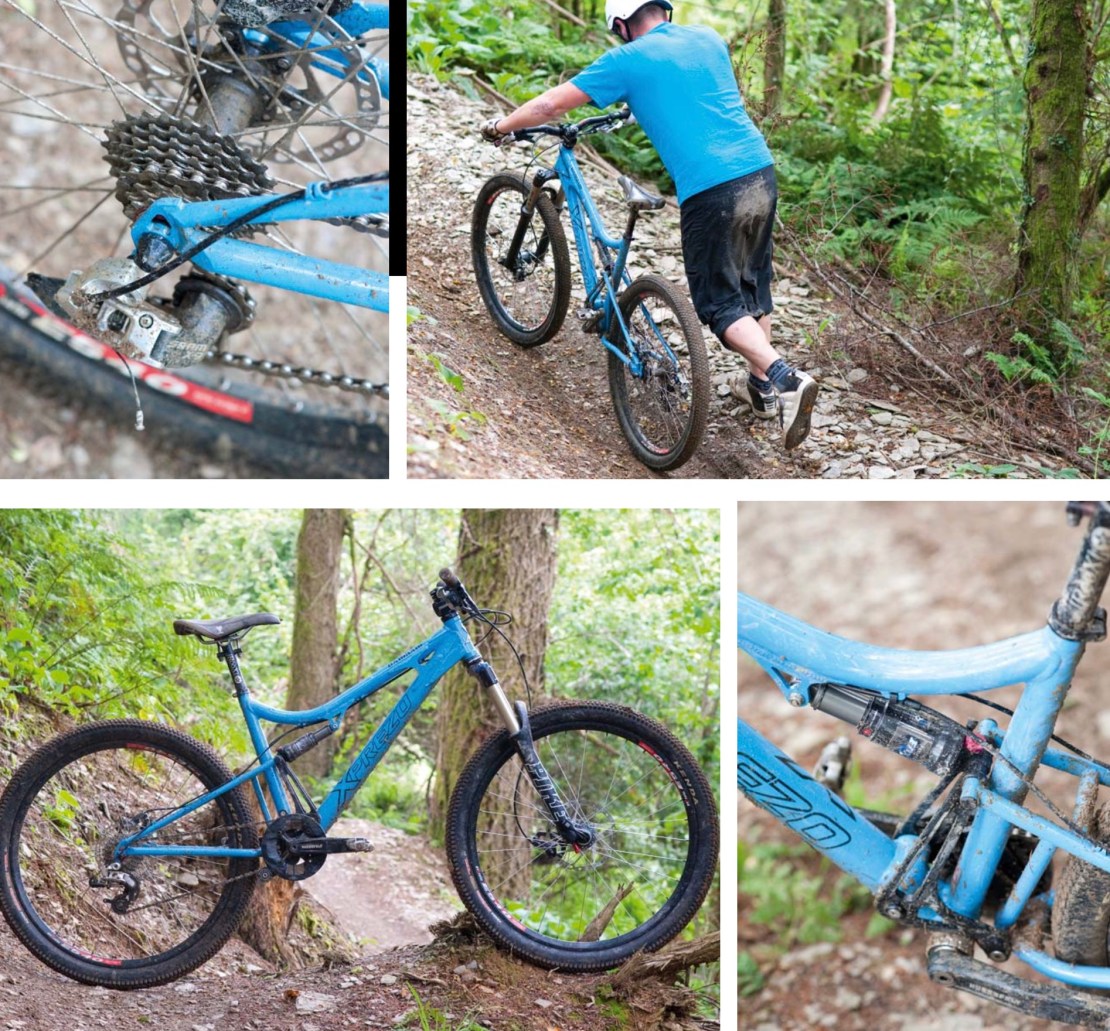
XPrezo are a Canadian company founded in 2003 who like to do things a little bit differently. Most of their bikes are made from two different materials: the front triangle being aluminium, the rear swing arm being steel. They do claim that they do this for functional reasons but we can’t help but think that there’s a little part of them that does it that way “just because”. The Detail Much like the Kona Bass, the Gamjam isn’t strictly a pure “4X” bike. Xprezo say it’s for people who “prefer to stay away from long travel bikes”. They go on to state that the Gamjam “will shine on technical courses, in the park or as an all-around playbike”. We shall see. The rear travel of the Gamjam is 4.5in – which is achieved through a relatively short Fox Float R rear shock (150mm eye-to-eye with a 38mm stroke). The suspension design is a classic single pivot. Don’t go thinking that the black strut is a pivoting linkage – it isn’t. The use of aluminium for a front triangle doesn’t need much explaining (it’s stiffer and lighter than steel). But why use steel for the rear? Xprezo say: “In equal section, steel is proportionately three times stiffer than aluminium and its resistance to fatigue is far superior. Thus, despite being submitted to such high levels of stress, the rear triangle boasts superior stiffness and durability while offering exceptional ride characteristics”. In other words when dealing with structures made up of shorter, narrower tubes (as on the Gamjam’s swingarm) they feel steel is stiffer and stronger. The Gamjam has some fairly unique stuff going on: a slack 66 degree head angle, a steep 73.5 degree seat angle, a shortish effective top tube (21.5in), a short head tube (4in) and behind this there’s a lot of bracing and gussetry, and behind that is a very dipped top tube that offers acres of standover. The Gamjam also has a proprietary built-in chain guide (single chain ring setup).
It’s only available as a frame but we should point out that it came with a coil-sprung Rock Shox Pike 454 U-Turn (95-140mm travel). The Ride It’s always good to a get a bike that’s a bit different. And the Gamjam is very different. When the “radder” members of the Singletrack Test Squadron read that it had a slack head and a short head tube they couldn’t wait to have a go on it. They couldn’t get their heads around it. It had “flip-floppy” steering and felt too slack – again, slackness has always been a Good Thing before. It felt too low at the front – a low front end is something they’re always saying is a Good Thing! Cue the tape measure and lots of scratching of heads. The head angle was indeed a bit too slack for ripping around trail centres. The short top tube and not-low BB(13in) made us feel a bit too tall and top heavy. It took us ages to work out how to ride the Gamjam. In the end it worked best in two quite distinct guises… With the fork wound down it was a great straight-line dirt jump bike. We can imagine better riders than us using the Gamjam as a very effective “Slopestyle” stunt bike. Double backflips ahoy! The other guise we liked was with the fork wound out and running a higher rise (50mm) handlebar. This reduced the “falling over the front” feel and turned the Gamjam into a mini DH bike. Although this slackened the head angle even more it also meant we could go at speeds (and over rough terrain) where super slack head angle works. We didn’t feel limited by only 4.5in of travel at the back. And the back end didn’t feel flexy at all. The “hardcore hardtailers” amongst us loved it.
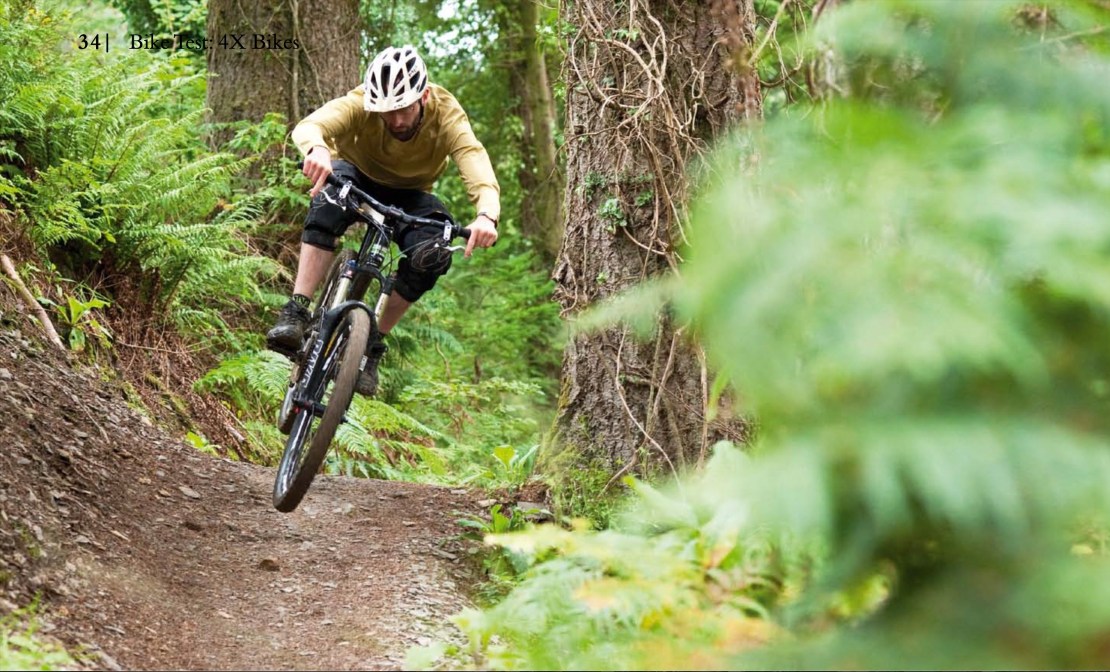
Conclusion
Another Commencal Meta, another great bike. Remarkably different to the regular Meta 4. Not as efficient maybe, but so much more fun. The taut feel of the suspension and the shorter, lower stance worked brilliantly together. It’s a bit on the short side for riding in terrain with steep gradients but for trails where you don’t really bother too much with the inner or outer chainring it’s one of the most joyous bikes you can get. Trail Centre-tastic in fact. The Foes felt the most overtly “4X” of all the bikes on test. It had the hardtail-esque pinpoint handling accuracy and the incredible pedalling efficiency that a racer would demand. And the suspension didn’t feel obtrusive or undesirable when pumping the terrain. It’s not a bike for everyone and it mainly makes sense on manmade trails, but if you want an “off-road BMX” – here it is. We loved the Kona Bass. It’s an excellent bike for progressing your skills on. It encourages all kinds of silly behaviour but it also has the solidity and predictable handling to get away with silly behaviour. It’s a shame that a fairly expensive bike needs a different fork and a set of brakes to realise its potential. Here’s hoping the 2010 model addresses these issues. The XPrezo Gamjam is quite an odd bike. But the world needs odd bikes in our opinion. It’s definitely worth trying if you’re a wannabe “Slopestyler”. If you’re more interested in its “Mini DH” potential then we’d recommend getting a larger size than you may think (for the longer top tube) and sticking a massive riser bar on there. We’re looking forward to having more XPrezo bikes to play with.
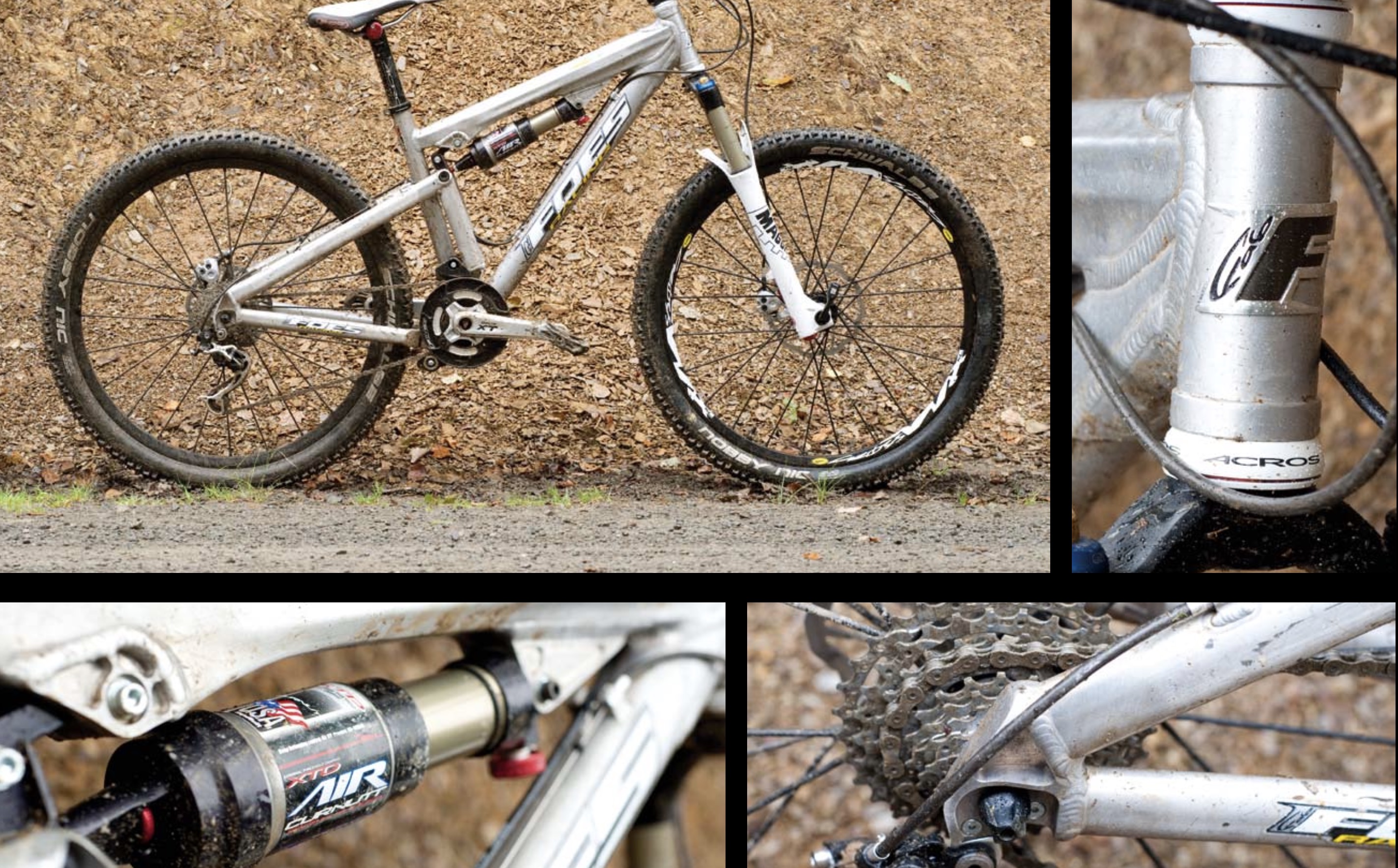





I need another Foes in my life.
Remember reading this when it came out and the style of bike appealed but I never had the funds. A few years later and a Commencal Hip Hop showed up in the classifieds and it had to be mine. Bit more travel at the back but not much different to those 4x bikes.
https://singletrackmag.com/2014/05/commencal-meta-hip-hop-2/
Modern 29ers show up the climbing ability as incredibly poor but the agility on the descents is incredible. Only bike I’ve ever felt comfortable getting (slightly) airbourne on. It will probably be the bike I take when I get round to going to BPW or similar.
I had a Kona Howler (like the Bass, but a bit lighter and without the BB pivot point), it was great fun for pretty much everything from XC to mini DH and dirt jumps and even a bit of 4X and duel.
I basically wanted an XC bike (turns out what I really wanted would have been a Downcountry bike) that was strong enough to thrash down everything that my DH bike was too big for or needed pedalling.
As the article said, they were too short and steep (weren’t most bikes back then) and even the Gravity Dropper hadn’t really taken off yet.
The frame is still in the barn and I might build it up sometime seeing as I still have a set of 150mm Z1 Freeride forks and some Dirt Jumper 1s (although they’re still on the jump/pump/Dadcountry bike and see regular use).
^ curse the broken forum display of Flickr.
So bikes for enjoying (man made) trails rather than race times – something I’m fully a fan of. over 30lbs, and that’s with tiny wheels, tiny cassettes and no droppers. and close to 2k for an alloy frame a decade and a half ago.
when people whine that bikes were better before and the industry these days is ripping us off with overweight/overbuilt half arsed designs, I shall refer them to this article.
Interesting old review. The thing that gets me is the cost of just the frame/shock combo. Seeing as you can get a half decent bike for that sort of money now, crazy. Although I do appreciate the frames were niche even at the time and two of the manufacturers are also niche.
The Xprezo is built the opposite way to how Cotic do things isn’t it? I think they use steel for the front triangle and aluminium for the rear end.
Shame there isn’t a bike version of the car ‘how many left’ website (which looks to be down at the moment). I doubt there’s many of those Commencals left 😀
I think peak “HOW MUCH!!!" has passed for now.
Stupid bikes like that £20k S-Works have always existed in one form or another, maybe less mainstream brands, but they’ve always been there. The bigger problem was 2015-2020-ish, before the Rockshox 35, Marzocchi Z2 etc. The options for reasonably priced bikes just disappeared. There was the odd Bossnut, or Marin did something similar. But on the whole the ‘entry level’ to bikes with 12 gears and non-steel stanchioned suspension was heading toward £3k! £2k+ was buying you rockshox Judy forks, and NX/SX gearing that fell apart. £3k-£4k might have been buying amazing bikes with Pikes / Lyrics / 36 / XT / XX etc but nothing had trickled down and the leap forward in frame design made 2nd hand unappealing.
I think Shimano releasing 12s Deore, and Sram the RS35 probably forced SRAM to sell GX at a more affordable price point and Fox to make the Z2. And from that point on I don’t think we’ve ever had it so good for ‘entry level’ bikes.
Had a Meta 4X, genuinely one of the most fun, and surprisingly capable, bike I’ve ever owned.
Did everything from p**sing around in the woods, trail centres and even big mountain rides (the joys of being in your 20s and able to stand up to pedal for prolonged periods).
Wish I’d never sold my Blur 4X sometimes…
A properly capable, versatile bike!
For the time. It’ll look tall, short and twitchy as hell these days.
I built up my old DH bike over Covid. It was awesome back in the day but now it’s such a different shape to my trail/enduro bike that it’s borderline unrideable, certainly for what it was intended for.
In 2016 (I think) I bought my first full suspension bike. A bird aeris for which I paid a fraction over 2k. I deliberately got it just over 2k as I had paid exactly 2k for my car and wanted the bike to cost more.
that got me a pike, xt drivetrain (or possibly xt shift and deore mech), zee 4 piston brakes and dot Swiss wheels. admittedly No dropper as I was moving my existing one from my hardtail.
Geo and most of the spec still competitive today, although the bike was not without its flaws.
you could get a Capra (with unserviceable boss forks), a very heavy Meta, or a canyon something or other for similar money.
id give the direct sales brands (and crc grey imports) more credit than sram/shimano for getting us cheap good bikes
Yea, direct sales growth should get some credit as well, though they existed before then as well. Especially Bird bringing in what was at the time really out-there geometry at a sensible price.
Partially it was definitely because the rapid adoption of 29ers and long/slack geometry just made 2nd hand bikes unappealing. So I think there was a delay while manufacturers probably capitalized on a boom selling upmarket frames with the new standards before trickling it down. That probably applied both to component manufacturers and bike companies with the faster turnover of direct sales probably meaning they trickled down quicker.